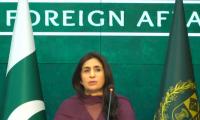KARACHI: The World Bank is bullish on Pakistan’s cashless economy potential, estimating it at significant $36 billion and projecting a straight seven percent boost to GDP with a real-time retail payments gateway, but all, it says depends on a widespread use of online financial transactions.
“To unlock Pakistan’s $36 billion digital finance potential, it will take high-level commitment, faster payments gateway, lower costs, fast track licencing for fintech (financial technology) sector and digitisation of all government payments,” World Bank Country Director for Pakistan Illango Patchamuthu said in a tweet.
Widespread use of digital payments in Pakistan offers a 7 percent boost of GDP, can create 4 million jobs, mobilise over $250 billion in deposits and formalise large parts of the cash economy,” Patchamuthu added.
Pakistan, despite having the fastest-growing internet-savvy populations, has an insignificant use of online payments. Lack of literacy and heavy reliance on cash are hindering growth of digital payments although access to internet-connected devices is increasing significantly.
Patchamuthu sees half of the population of 213 million shifting to digital payments within a year and the country outperforming regional economies, like India and Indonesia if the government introduces a real-time payments gateway.
“A real time retail payments gateway and a booming fintech sector can accelerate the use of digital payments in Pakistan to at least 50 percent of the population by 2020,” he said. Only 18 percent of population uses digital payments in Pakistan now. A Pakistani will make only one digital transaction per year compared to 5 in India, 7 in Indonesia. Pakistan can accelerate digital payments and leapfrog its peers.” While private sector’s businesses, known as fintech, are introducing mobile wallets and local gateways, the local platforms are not capable to remit foreign currency from across the border, impeding the goal of cashless economy.
Ecommerce market size grew around 94 percent year-on-year to more than Rs40 billion last year but the 90 percent of payment transactions were through cash-on-delivery. The ministry of commerce called for a need of enabling card-not-present transactions and to explore the possibility of cobadging with international card payment schemes. “International payment gateways like Visa and Mastercard exist in Pakistan that facilitates the merchants for e-commerce transactions, both national as well as international,” the ministry said in the ecommerce policy framework. International payment gateways for routing payments would “require bilateral agreements with countries individually to route remittances to Pakistan,” it added.
The government, last week, approved the maiden framework to unlock the ecommerce potential through removing regulatory snags.
“MOITT (ministry of information technology) in collaboration with SBP (State Bank of Pakistan), will approach PayPal and other payment gateways to ensure availability of international payment gateways in Pakistan,” the ministry said in the document. The central bank planned to introduce faster payment gateway next year, saying “government payments and receipts and merchant payments to be the key elements in accelerating digitisation of payments in the country”.
Sheikh argued that the government should have maintained stable petroleum prices
MARI has successfully drilled and tested the third appraisal well in the Ghazij formation in the Mari D&PL
Gold rates decreased by $17 to $2,395 per ounce in the international market
Company's revenue saw a 13.9% year-on-year increase, reaching Rs49.2 billion, up from Rs43.19 billion in the same...
A man counts US dollars in a money exchange shop in Dhaka. — AFP/FileLAHORE: The first thing that the government...
Power generation stood at 8,741 gigawatt-hours or 11,749 megawatts in March







